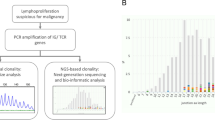Abstract
The understanding of the molecular mechanisms associated to lymphoid neoplasia has significantly improved in recent years due to technological advances. Molecular markers have been identified, allowing initial diagnosis. Genomic rearrangements can help to affirm clonality or indicate the disease entity. Some markers are also researched for their prognostic value. Finally, some rearrangements can be used for residual disease assessment during clinical course.
Résumé
La compréhension des mécanismes moléculaires associés aux hémopathies lymphoïdes a considérablement évolué ces dernières années du fait des avancées technologiques. Des marqueurs moléculaires ont été identifiés, permettant de mieux poser le diagnostic initial. Des réarrangements géniques peuvent aider à affirmer une clonalité ou préciser l’entité clinique. Certainsmarqueurs sontégalementrecherchéspour leur valeur pronostique. Enfin, des réarrangements peuvent être utilisés pour évaluer la maladie résiduelle au cours de l’évolution.
Similar content being viewed by others
Références
Alizadeh AA, Eisen MB, Davis RE, et al. (2000) Distinct types of diffuse large B-cell lymphoma identified by gene expression profiling. Nature 403: 503–511
Brüggemann M, White H, Gaulard P, et al (2007) Powerful strategy for polymerase chain reaction-based clonality assessment in T-cell malignancies Report of the BIOMED-2 Concerted Action BHM4 CT98-3936. Leukemia 21: 215–221
Campo E, Swerdlow SH, Harris NL, et al. (2011) The 2008 WHO classification of lymphoid neoplasms and beyond: evolving concepts and pratical applications. Blood 117: 5019–5032
Fu K, Weisenburger DD, Greiner TC, et al (2005) Cyclin D1-negative mantle cell lymphoma: a clinicopathologic study based on gene expression profiling. Blood 106: 4315–4321
Ghia P, Stamatopolos K, Belessi C, et al. (2007) ERIC recommandations on IGHV gene mutational status analysis in chronic lymphocytic leukemia. Leukemia 21: 1–3
Hamblin TJ, Davis Z, Gardiner A, et al (1999) Unmutated IG V(H) genes are associated with a more aggressive form of chronic lymphocytic leukemia. Blood 94: 1848–1854
Hans CP, Weisenburger DD, Greiner TC, et al. (2004) Confirmation of the molecular classification of diffuse large B-cell lymphoma by immunohistochemistry using a tissue microarray. Blood 103: 275–282
Lossos IS, Czerwinski DK, Alizadeh AA, et al (2004) Prediction of survival in diffuse large-B-cell lymphoma based on the expression of six genes. N Engl J Med 350: 1828–1837
Mozos A, Royo C, De Jong D, et al. (2009) SOX11 expression is highly specific for mantle cell lymphoma and identifies the cyclin D1-negative subtype. Hematologica 94: 1555–1562
Pott C, Hoster E, Delfau-Larue MH, et al (2010) Molecular remission is an independent predictor of clinical outcome in patients with mantle cell lymphoma after combined immunochemotherapy: a European MCL intergroup study. Blood 115: 3215–3223
Rambaldi A, Carlotti E, Oldani E, et al. (2005) Quantitative PCR of bone marrow BCL2/IgH-cells at diagnosis predicts treatment response and long-term outcome in follicular non-Hodgkin lymphoma. Blood 105: 3428–3433
Schraders M, de Jong D, Kluin P, et al (2005) Lack of Bcl-2 expression in follicular lymphoma may be caused by mutations in the BCL2 gene or by absence of the t(14;18) translocation. J Pathol 205: 329–335
Van Dongen JJM, Langerak AW, Brüggemann M, et al. (2003) Design and standardization of PCR primers and protocols for detection of clonal immunoglobulin and T-cell receptor gene recombinations in suspect lymphoproliferations: report of the BIOMED-2 Concerted Action BMH4-CT98-3936. Leukemia 17: 2257–2317
Wlodarskal I, Dierickx D, Vanhentenrijk V, et al (2008) Translocations targeting CCND2, CCND3, and MYCN do occur in t(11;14)-negative mantle cell lymphomas. Blood 111: 5683–5690
Author information
Authors and Affiliations
Corresponding author
About this article
Cite this article
Boulland, M.L., Fest, T. Diagnostic moléculaire des hémopathies lymphoïdes matures. Oncologie 13, 537–541 (2011). https://doi.org/10.1007/s10269-011-2061-5
Received:
Accepted:
Published:
Issue Date:
DOI: https://doi.org/10.1007/s10269-011-2061-5




